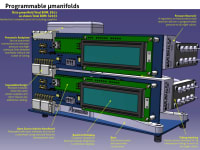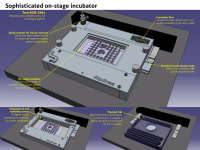Advances in microscopy have made single cell analysis an important approach in both the study of cell signaling pathways and in high content analysis used in drug development. Microfluidic techniques have further enhanced these approaches and there has been an enormous explosion of new assays and techniques developed to exploit the advantages of this approach. One of the bottlenecks in the growth of microfluidics has been the lack of availability and the expense of devices to implement these experiments. Our approach addresses this need.
Our platform not only offers both immediate and long-term benefits to scientists using microfluidic devices in their labs, but also creates the foundation of new commercial opportunities for products and services. The platform consists of:
1. Valve manifold delivering a programmable pressure to 8 ports, expandable to 96 ports.
2. Microscope-mounted cell culture chamber with programmable temperature and CO2 control.
3. Chip-to-world interface that is uncomplicated and reduces setup time to minutes.
The long-term goal is to create a self-sustaining community to continue development of this and other open source products for biology research.
Our platform expands the potential user-base of microfluidic devices by addressing two challenges facing scientists using microfluidic devices in their labs, the chip-to-world interface and the pneumatic control manifolds. First, the chip-to-world interface eliminates error-prone steps from experimental setup, reducing setup time to minutes even for inexperienced users. Second, the programmable manifold replaces complicated tubing and wiring connections with an elegant, all-in-one product capable of delivering an adjustable pneumatic pressures to as many as 96 ports. If these two challenges are overcome, the remaining challenge of fabricating the microfluidic devices can be sidestepped if the microfluidic devices are provided by scientific collaborators, or purchased from an academic or commercial microfluidic foundry.
Over the long-term, this platform will drive adoption of microfluidic devices, thus increasing innovation in biology research, for three reasons. First, it's ease-of-use lowers a significant barrier to adoption by new scientists. Second, even seasoned microfluidics researchers will adopt the open source designs as foundations to tweak and modify because doing so both obviates the need to reinvent basic common functions and also allows them to reap the benefit of a community-tested design. Third, this platform costs less than comparable commercial products, even when ordered in quantities of 1 or 2 units, by using readily available 3D printing and contract PCB assembly vendors located in the US, lowering another potential barrier to adoption by scientists.
Despite the fact the designs will be open source, the consolidation of microfluidics infrastructure will create new markets and other opportunities for companies. For example sales of subscription-based customer support consumables such as reagent kits, and professional assembly services for convenience or regulatory reasons. These designs may also be incorporated into commercial products analogous to how TiVo DVRs use Linux as their underlying operating system. Indeed, many successful business models in the open source software industry may translate to an open source scientific product industry.
Like this entry?
-
About the Entrant
- Name:Carlo Quinonez
- Type of entry:individual
- Software used for this entry:CATIA, Altium Designer
- Patent status:none








